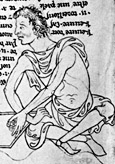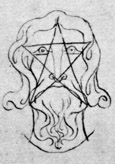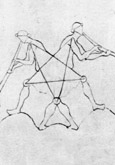Sketchbook of Villard de Honnecourt (original) (raw)
Sketchbook of
Villard de Honnecourt
 |
 |
 |
 |
|---|
Of interest to students of sacred geometry, several examples of the pentagram are found in Honnecourt’s sketches. Three of the seven were decorative while the remainder were intended as guides for drawing. An argument could also be made that they demonstrate a familiarity with the importance of the golden ratio. The pentagram had another, more mundane meaning to the cathedral builders. "The pentagram belongs to the symbols that represent the builders: it occurs together [on Roman Republic coins] with such symbols as the base of a column, a Corinthian capital, plaster’s float, trowel and builder’s square."
| XVII: | one depiction on coin or game piece. |
|---|---|
| XVIII: | depiction on wall of tabernacle, possibly Laon Cathedral. |
| XXXVI: | three depictions as guides for drawing faces, towers and birds. |
| XXXVII: | one depiction in a flower and one as a guide for positioning of human figures. |
Detail: The Sketchbook of Villard de Honnecourt. Edited by Theodore Bowie. Bloomington and London: Indiana University Press, 1959 LCCN: 68-14615
Facsimile of the Sketch-book of Wilars de Honecort... published by M. Alfred Darcel from the MS. of M. J.B.A. Lassus... translated, edited and augmented... by the Rev. Robert Willis. London, John Henry and James Parker, 1859.
MS. 19093 French Collection, Bibliothèque Nationale, Paris [No. 1104 Library of Saint-Germain-des Prés until _c._1800]
Cornelia J. de Vogel, Pythagoras and Early Pythagoreanism, An Interpretation of Neglected Evidence on the Philosopher Pythagoras. Assen, Netherlands: Van Gorcum, 1966, p. 38. Citing: Brit. Mus., Catal. Greek Coins, Italy, p. 59, nr. 29; Haeberlin, Aes grave, pl. 68, nrs 20-22 and 32; Syndenham, Aes grave, p. 103, nr. 117, pl. 13, 7.